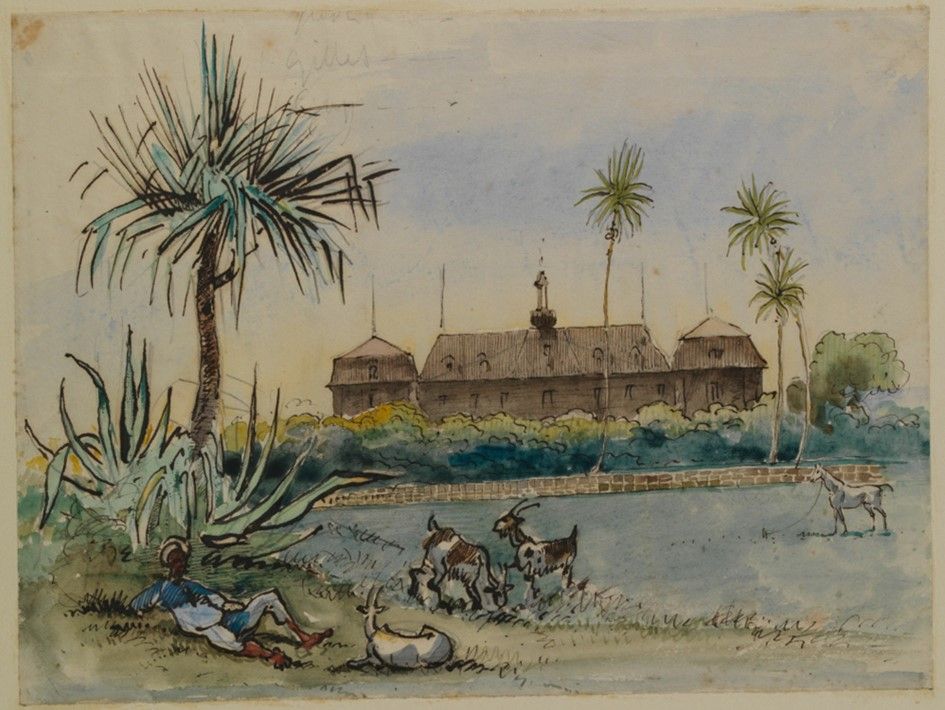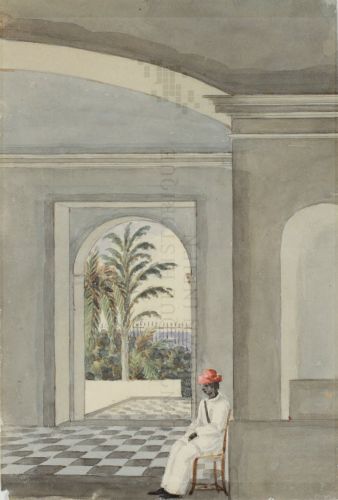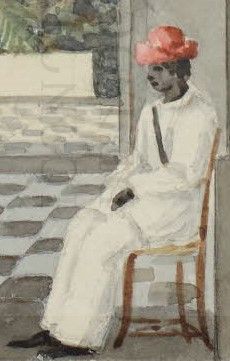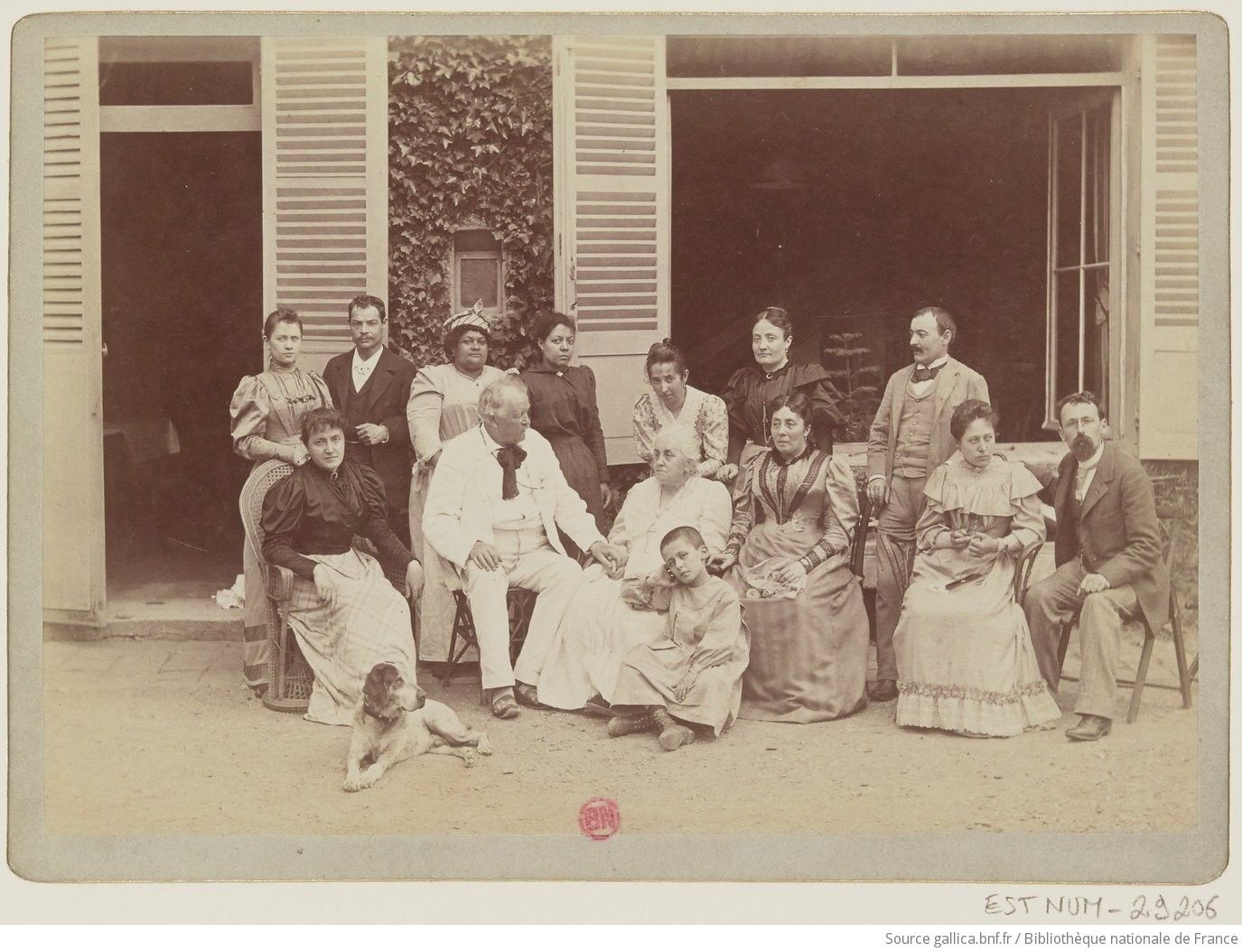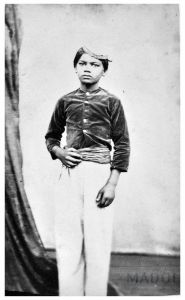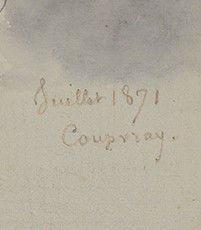Rokonstitusyon bann Zabi Boutchiana
Parti 1: Lo kontèks istorik
Boutchiana
Le moun i aparé dosi 3 zakwarel do lartis Hippolyte Charles Napoléon Mortier, Duk de Trevise danntan la mwatié lo diznévièm sièk.
in ot, kadré an bust, lé daté an Julié 1871
Bann lakwarel li provwien lo bann koleksyon ekstansiv l' Ikonotèk Istorik l'Oséan Indien (IHOI), semnb lèr émab permisyon
Kisa téi lé se moun mistéryé la, klerman li té i sort Lind, é la atir latansyon lakwarélis sak lété menb par maryaz la famiy Le Coat de Kerveguen (pou ki lu té travay)?
Kisa lété Boutchiana ?
Nou koné présk aryen si li, pou vréman dir zéro kalbas : toute sak i prouv li té la, sa lé bazé si trwa zimaz la èk in ti páragraf pou in zémigré Indyin ké la ariv Larényon an mil uit san swasant-yin anndan bato Canova, ansanm èk plizyèr dot zangajé zot la prenn pou travay si lil, ké dalor té an plin boum la kann.
Nout mistérié lindyien té listé native lo Yanam, ek tayèr konm profesyon. Li té rienk 17 an.
Pa mié.
Ah, si: enndan son bann memwar Mortier de Trévise la ékri an 1891, li koz la lis lo bann servitèr li la koni a la kaz son bofrèr, labitasyon des Casernes, a Saint-Pierre, pendan son promié sotman la mèr an 1861. Lo non Bouchiana i aparé dodan la lis.

Rokonstitisyon bato Canova, in gadiamb makèt ké lé dann domèn Canabady (ant Tanpon ek Sinpyèr) si lanplasman lansyen domèn Mon Caprice, lété posesion la dinasti Kerveguen pi vendi in désandan zangajé parapré.
>In mystérié Lindyen
Partannla, in bonpé késtyon i vyin dann nout koko :
- Akoz li la kit Yanam si zèn koméla ?
- Eské li té i sort pli lwin ké le kontwar fransé si frondmèr Lès Lind ?
- Ousa li la gayn sé ti zoli manyir la ké Mortier de Trévise i arkoné ?
- Ek akoz li la romark ali ?
- Eské li té vréman tayèr ?
- Dann kèl kalité kaz li té vi ?
Pou fé kourt, lo mistèr i riskab rès konméla lontan ankor, konsidéran napwin dot rosours pou krézé.
Reskap, an portan lintéré si out zabiyman, ou téi gayin dékouv ankor in ti pé ?
In Liniform domestik
Sak i arsort direk si trwa zimaz Mortier de Trévise la lès dèryèr la, sa lé ké son zabiyman la rést présk parèy ant 1865 ziska 1871 ! Son rad té fé èk in latwal blé indigo, avèk in kol blan ek bann mans blan osi, ek téi boutoné dovan la shémiz. Bann zorneman blan la té petèt lo sign ké téi mark lédomestik dan la famiy Kerveguen ?
Dépi 1861 déza, Boutchiana i aparé dodan la lis lo bann servitèr lakaz ké Mortier de Trévise la sité :
Pou fini, mi dwa koz Èjéni, la gouvernant milat ké téi okip mon bofrèr kan li té ti baba, ek Viktorinn, la vyé fam, kom Emma téi apèl ali ek i apèl ankor ali nénèn.
Dann lékiri na Morin, in vyé kaf ké lé koshé dopi toultan ek li lé byen débrouyar.
ek Péroumal, Indyin, li osi in bon koshé.
Dann gardmanzé Lazèr, Indyin, bon servitèr.
Madrouka la byin okup de mwin pandan mon maladi.
Baraka la rès mon servis onz an + an Pari.
Bouchiana, marié, i viv Lind apré ke li lété dann servis mon bofrèr pandan plizyèr zané.
Nout lotèr i koz néna uit servitèr koté létablisman lo Kazèrn an 1861.
Lé presk sir navé enkor in takon
In rosansman zot la fé an 1877 la mont ke navé 22 servitèr anplwayé si plasman Kazèrn. Lé vré ke sa téi lé in domèn gadyamb pou Lil Larényon : in bèl gran kaz mèt ek kat paviyon akolé èk sa, inkli sélsa Msyé Bourayne téi rèst dédan, ké téi fé konm in zafèr zérant domèn pandan lo pasaj Mortier de Trévise.
In ot kalité domestik
Gouvernèr lil navé osi bann domestik, bana lété koni sou lo non "pion du gouverneur".
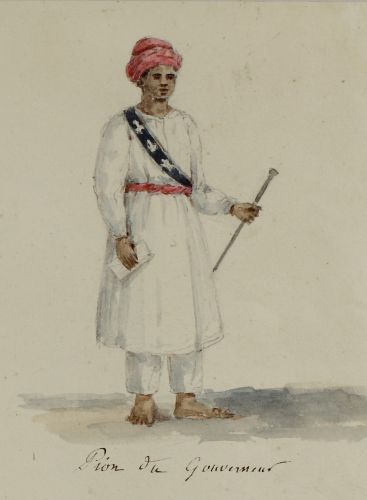


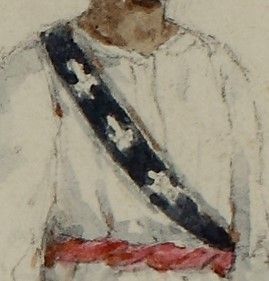
This symbolises the role of the Governor: he is the direct representative of the King of France, Charles X, via his Ministry of the Navy and the Colonies.
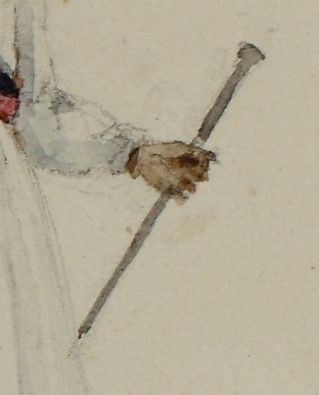
Would he be the leader of the troupe of domestic pawns?
Detail of a watercolour by DUMAS Jean-Baptiste (1792-1849), 1827, annotated "Governor's pawn".
Clothing really helps to identify the person and their function
The role of a domestic
Mortier de Trévise's enumeration shows that the domestic staff working in the barracks had nothing to envy that of a large European house: a dozen servants showed great financial ease in the eyes of contemporaries. Twenty or so, and you're in the category of the very rich.
For the Kerveguens, having two coachmen was already a luxury.
It should be noted that Morin, the first coachman mentioned, is referred to as a "former black", which means that he was a slave in the family before 1848. If he was already working as a coachman before the French emancipation from slavery, then he must have been somewhat remunerated from time to time, as he belonged to the category of "talented" slaves. The fact that Péroumal, a hired Indian, was also a coachman perhaps indicates that the oldest trained the other? No doubt not without difficulty, or rivalry, as the new recruits generally did not appreciate having to depend to a greater or lesser extent on freedmen, i.e. former slaves.
In any case, Mortier specifies these distinctions in his brief enumeration, which indicates that the subtle hierarchy among all the workers subject to the master of the estate was very important, and did not always make social life very simple.
The recruiting landlords employed the same tactics as in the days of slavery: mixing the populations of workers in order to avoid organised groupings as much as possible.
This magnificent period photo shows the couple living in Metropolitan France, surrounded by their servants: out of 13 adults, 11 are servants, which is no mean feat.
"Félix Nadar and his wife Ernestine surrounded by their employees and servants in their hermitage in the Sénart forest" (1887-1894). Credit Gallica
Here is the account given by Louis Maillard, a colonial engineer who was stationed for several years on Reunion Island (Bourbon), in his Notes sur l'île de La Réunion, Bourbon, published in Paris in 1863:
"The mixture of races and castes, in the slaves of Bourbon, contributed much to the tranquillity of the country. As the Cafres and Malagasies generally had little in common with the Indians and Malays, and all the latter were considered to be of an inferior race by the Creole slaves, there was a continual antagonism between them which hardly allowed any of them to hatch any disastrous plans unless they were denounced by the others".
For domestics, the engagists preferred very young boys, which was the case for Bouchiana when he arrived: barely seventeen years old. He was therefore a minor.
Who accompanied him on the boat across the Indian Ocean? Did he have authorisation from a parent or grandparent?
This was the case for Zéganadin, son of Pavalé, aged 15 when he arrived on board the Félix on 28 April 1862, and hired as a domestic servant with the consent of his uncle Ramassamy, or Moutoukichenin, aged 14, a domestic servant who came on board with the consent of his uncle Covindin.
That said, we need to be sure of the family relationship...
AZEMA Constant (1828-1877), "Indian child, young domestic servant", Credit Musée des Arts décoratifs de l'océan Indien, 18P1.7_PHO.2012.2274.70a
How many domestics are there on the island?
In 1887, for example, following the official cessation of Indian immigration, at least from the regions subjugated by England, as a result of the breach of the Franco-British agreement governing the terms under which indentured labourers were recruited, the population stood at 163,881.
The ethnic composition breaks down as follows - according to the criteria of geographical origin established by colonial statistics, and reproduced in a small work published on the occasion of the International Exhibition of 1887:
Click to enlarge
There are some clarifications to be made to this table:
of the 120,532 French nationals in 1887, a large proportion were :
- Creoles,
- Madagascans,
- Cafres
- Indians
who were no longer indentured servants, but had integrated into Réunion's colonial society by becoming settlers.
What is a "settler"?
They are farmers on a piece of land entrusted to them in sharecropping by their former employer.
The settler is called a "partiaire" because, as he is not the eminent owner of the land he cuts, he has to share the fruits, i.e. the harvests, with the owner; in general, the split is 2/3 for the settler, 1/3 for the owner.
Not included are 200 Chinese and 576 "Arabs" from Yemen and northern India. To this must be added a floating population of 2,378 people, in naval troops, asylums or prisons. The Third Republic, in place since 1870, favoured the integration of many of these former workers.
On Réunion, there are three main reasons for the large number of domestic workers in general
with a clear preference for Indians, a peculiarity noted by several travellers in the second half of the 19th century, including Louis Maillard, a colonial engineer who worked in Réunion for several years around 1860:
"Take the sturdiest and healthiest; they are more or less incapable of working the land, and have at most enough strength and energy to be domestic servants, a job for which a certain intelligence makes them quite suitable".
1 is the considerable number of domestic servants on the island, far more, proportionally, than in the French colonial metropolis. In 1887, for example, out of a total population of 163,881, there were around 5,500 domestic servants throughout the island and 2,000 caretakers; there were also 15,000 labourers.

Table taken from Jean Régis Ramsamy-Nadarassin's doctoral thesis in contemporary history, Les travailleurs indiens sous contrat, 1848-1948, Entre le retour programmé et le début des intégrations, tome 1, Université de La Réunion, 2012.
We can see that the proportion of servants of Indian origin was reversed between 1860 and 1890: The reason for this was that, on the one hand, the owners of the cane fields preferred labour from the African continent, considered to be more resistant to the hard work in the fields, and on the other hand, the Indians themselves, after the abandonment of the Franco-British agreement of 1887 for the recruitment of workers, were able to become landowners and take on Indian servants, who were trained in Indian religious practices, mostly Tamil, and in the forbidden practices.
Another example: in 1887, out of a total population of 163,881, there were around 5,500 domestic servants throughout the island and 2,000 guards, to which must be added 15,000 labourers, according to Les colonies françaises: notices illustrées. Volume 1 (I-II) / published by order of the Under-Secretary of State for the Colonies; under the direction of Mr Louis Henrique,.... 1889-1890
2 is that many of the servants were men, at least in this large family. On average, historians have been able to calculate that the proportion varied from 10% in the early days of immigration, to 40% around 1880-1890, because the owners realised that importing Indian workers was an expensive operation: they had to pay the premium to the mestry, i.e. the recruiting agent on the spot in India, and advance the costs of transport, food and clothing. Labour recruiting landlords quickly decided to stabilise the local settlement of Indian immigrants by encouraging the formation of families. That way, they wouldn't have to pay for the return journey, which was part of the contract!
However, it should not be forgotten that there were also cooks, seamstresses and laundresses. Bear in mind that the "nénènes", like Eugénie or Victorine, were often also involved in sewing. On average, the proportion of women was less than half to two-thirds that of men. Unfortunately, this encouraged violence against women, who were often trafficked between the males in the enlisted camps, according to the trial reports still available in the Departmental Archives and analysed by the historian Prosper Eve.
In this particular demographic situation, how did Bouchiana meet his future wife? On Réunion? We don't know yet.
3 is the salary: the employees of the Kerveguen family are paid in Kerveguen: coins from Austria, which had just been demonetised and which Gabriel Le Coat de Kerveguen had imported, with the authorisation of the local authorities, from 1859;
These 220,000 coins were in circulation at the forced rate of 1 franc, worth 0.86 in silver.
In fact, the quantity of cash circulating in the French colony, as in the other colonies for that matter, was not sufficient. For example, when Cail - a major French industrial company manufacturing steam engines and all kinds of sugar-making equipment - was planning to build central factories on Reunion Island, it was hampered in its objective by the embarrassment caused by the lack of currency: "the shortage of currency has become extreme; it is causing the most serious difficulties for the payment of salaries on the farms and for all payments; at every moment we are stopped by the impossibility of obtaining the necessary change".

Reverse and obverse of a "kerveguen" coin circulating on the island between 1859 and 1879.
As a result, several types of currency were in circulation on the island: Spanish piastres, which had also been demonetised, francs, Indian rupees and a whole bric-a-brac of metal currencies of different denominations.
The Third Republic decided to put an end to this monetary anarchy in 1879, by having all currencies other than the Franc withdrawn. Prior to this date, Kerveguen, or silver coins, were widely used and had flooded the island. However, piastres, which had a higher metal content, were much appreciated by hired labourers.
And what about Boutchiana?
It is likely that he was paid in this way, unless he expressly wanted to be paid in piastres, which was the case for many of the recruits. But did he have a choice?
Portrait of Boutchiana, by Hippolyte Charles Napoléon Mortier, the Duke of Trevise
His activities seem to have been those of a personal valet, for if we find him at Coupvray, the Mortier de Trévise estate, in 1871, it is because he had followed his boss, Denis-André de Kerveguen, on one of his trips to France.
If this is the case, Bouchiana looked after his boss's clothes and linen, helped him to dress, ran errands for him, and assisted him with the small activities of daily life at home and on outings. So he has a certain amount of trust from his master.
One comment, however: in the two watercolours showing our young character, front and back, we see him holding a spear rather proudly, almost in the manner of Jamali, sugarcane's guard. Before becoming his master's valet, did he do his apprenticeship as a keeper in the master's house?
A time-counted commitment

Recruitment booklet, 1901. Collection of the Archives Départementales de La Réunion
As for the duration of his enlistment, it is not known exactly: in principle, newly recruited conscripts sign for a period of five years, which may or may not be renewed.
Bouchiana was recruited in 1861, and in 1871 we can see that he was still in the service of Denis-André Le Coat de Kerveguen; but in 1891 Mortier de Trévise tells us that he had returned to India, and was married. He therefore remained in the family's service for at least ten years, and probably even longer, the time it took him to amass enough money to return to India with a comfortable standard of living.
Unfortunately, this was not the case for many of the indentured servants who returned to India, via Pondicherry, at the end of their contract, with hardly any savings, worn out and weakened by the hard work in the fields.
The regulations governing indentured servants stipulated that the return of indentured servants was to be at the expense of the State, or in reality the master, who in fact deducted a sum from the indentured servant's salary to cover any such costs. A register had to be kept by the colonial administration to record these returns.
While these registers are present in the archives of Mauritius, they are very rare and incomplete for the neighbouring island of Réunion. We have not found Bouchiana's name before 1891. Did he marry in Réunion? Or in India?
A researcher from Réunion, Jean Régis Ramsamy, has calculated that between 1851 and 1882, there were 62,683 entries of Indian workers, and 23,683 repatriations.
However, the number of deaths must be taken into account:
- either during the ocean crossing,
- or, even more so, on the cane plantations, where the work was exhausting and the workers were often ill-treated.
26,220 people died, i.e. 39.7% of entries.
Today on the island, every 11 November, the descendants of the indentured labourers commemorate the arrival of their ancestors on the site of the former lazarets.
So it is clear that the Bouchiana mystery is far from solved: we still have a lot to learn about the condition of the servants, their recruitment, and the return of the Indian indentured servants to their country of origin. More in-depth articles on these subjects will follow.
For further information
It should be noted that there are hardly any studies devoted to colonial domesticity as such, for the island of Réunion, or else gendered (women domestic servants).

Prosper EVE
Nouveaux propos sur les femmes à Bourbon/ La Réunion, XVIIe-XXe siècle, Surya éditions, 2015

Mareike KÖNIG
« La domesticité en Europe », Encyclopédie d'histoire numérique de l'Europe [online]
ISSN 2677-6588, uploaded 06/22/20

David NORTHRUP
"Indentured Indians in the French Antilles" (
In: Revue française d'histoire d'outre-mer, tome 87, n°326-327, 1rst semester 2000. Les Juifs et la mer, under the direction of Richard Ayoun. pp. 245-271.

Société de plantation, histoire & mémoires de l'esclavage à La Réunion
Article on Indian engagement in 19th century in Réunion island

Jean Régis RAMSAMY
"Les travailleurs indiens sous contrat à La Réunion" PhD thesis, Université de La Réunion, 2012
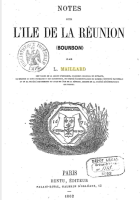
Louis MAILLARD
Notes sur l'île de la Réunion, (Bourbon). Paris, Dentu, 1862









